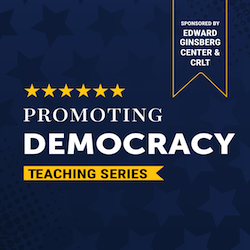
This piece is part of CRLT and the Edward Ginsberg Center's partnership to offer programming and resources for instructors around democratic and civic engagement through the Promoting Democracy Teaching Series. Our first piece, Preparing to Teach During the 2024 Election, provides a wider overview of the considerations.
Class discussions on policy, politics, and social issues, including those related to the 2024 election, can support students in a range of ways. They can help students progress towards course learning objectives. They can also promote democratic engagement by fostering students’ confidence, motivation, and capacity to make informed decisions at the polls. Moreover, students may develop lifelong civic skills and mindsets through discussions of important issues of our time. Lastly, they can provide space for students to process election rhetoric, news, and results affecting them and their communities.
To successfully support these goals, thoughtful design and facilitation of these discussions is crucial. CRLT and the Ginsberg Center have developed a framework for structuring classroom discussions around the election, relevant for any topic where the stakes are high for students, whether academically, socially, or in terms of the real-life consequences of broader debates and policy decisions. A key component of this framework is selecting activities that are aligned with your discussion’s learning goals. A well-aligned activity provides clear guideposts for students, helping them navigate complex and potentially contentious issues with purpose and direction.
In this blog post, we consider five common learning goals for class discussions around policy, politics, and social issues. We highlight structures that facilitate each goal, as well as a few specific activities that offer practical options for your class discussions, including those leading up to and following election day.
Preliminary Considerations
Before we dive into these five common discussion goals, we want to pause to underscore some best practices for structuring class discussion, regardless of your particular learning goal.
- Establish and revisit discussion guidelines/community norms. These lay out the ground-rules for productive discussions, which can be called on to guide conversations forward during unexpected hot moments.
- Prepare for ‘Hot Moments’ in the classroom with facilitation strategies and response language.
- Structure interactions to promote equity and a wider range of student participation with strategies such as seeding discussions in pairs or small groups, instructor-assigned or randomly-assigned groups, and starting a class discussion with a “round” activity.
Discussions to Uncover Beliefs, Values, and Assumptions
Classroom discussion can be an avenue for students to uncover and name their own assumptions about a question or topic (Brookfield 2005), in addition to their underlying beliefs and values. This goal is often a critical starting point for a long-term investigation into a policy question or social issue. Students will have a better understanding of their initial reactions to ideas discussed at later points. They will be in a better position to explain why they may prefer one option over another, or find one argument more persuasive than another.
For discussions with this type of goal, you may be looking for structures that:
- Provide time and space for students to think deeply. Most of us cannot do the work of surfacing underlying beliefs, values and assumptions while also listening and responding to others.
- Limit situations where students have to explain or justify themselves to others. Structures are key here because unstructured conversations can easily fall into this dynamic.
We could find classroom activities with these features simply by choosing an independent in-class writing or homework, rather than utilizing discussion. So what might be gained by a discussion-based activity? How might discussion with other students lead to a better understanding of their own foundations? With a suitable activity, discussion can:
- Provide students opportunities to hear from others to spark their own thinking and reflection.
- Facilitate peers as partners in drawing out underlying beliefs, values, and assumptions.
Specific activities you might consider are:
- Independent writing
- A reflection memo as pre-work to a class session with discussion
- A minute paper to be completed before a discussion activity or during a pause in the conversation.
- Peer interviews to facilitate peers as partners.
- The My Political Values activity from the Constructive Dialogue Institute is one example to adapt for your context.
- What Did You Know and When Did You Know It?
- A full-class discussion activity, where “students investigate how their knowledge and views of a topic have changed over time” and “consider the causes of changing views.”
Discussions to be Informed and Enriched by Others’ Perspectives
Discussion-based activities can be opportunities for students to develop a deeper understanding of and respect for a wide range of perspectives formed by diverse identities, experiences, and beliefs (Brookfield 2005). This discussion goal contributes to several crucial civic skills, such as “seeking, engaging, and being informed by multiple perspectives” (Crucible Moment 2012). It’s an early step in productive processes for collective decision-making. It’s a cornerstone of dialogic models of communication. It can work against polarization by strengthening understanding of why reasonable people who encounter similar information come to different conclusions.
To create supportive conditions for this type of goal, you may be looking for structures and activities with similar characteristics as our first goal, such as options that limit situations where students have to explain or justify themselves to others. You may also seek out structures that:
- Encourage active listening, limiting the tendency to immediately respond with our own thoughts or experiences.
Specific activities you might consider are:
- Conversation Café
- A “liberating structure” that supports wide participation and builds-in active listening.
- Redistributing Voices Activity
- The instructor asks students to write down their thoughts to a question or two on an index card. Students do not put their names on the cards. The instructor collects them, shuffles them, and redistributes them to each student. The instructors asks students to read what is on their new index card out loud to the group.
- Reflection questions or prompts include:
- What’s been your experience with ….?
- What was your initial reaction to this reading/image/clip?
- What’s one thing you hope your peers know about ….?
- Shared Text/Comment
- Students read and react to a text or source, share and listen to reactions of peers, and reflect on how positionalities (i.e., personal identities and experiences) informed their own reactions and those of their peers.
Discussions for Collaborative Inquiry
Discussions can facilitate collaborative learning (Brookfield 2005). In conversation with others, students may come to a better understanding of a policy, issue, or event and the relevant facts and the complex factors contributing to it. For many of us, reading an article, listening to a podcast, or watching something is just the starting point to understanding it. It’s in conversation with others where we make connections, realize our misunderstandings, understand implications, and have “a-ha” moments. We may have this goal for students when they are still learning the ins-and-outs of a complex topic, often before they are at the stage where they want to advance a position or come to a decision (Schmidt and Pickney 2022).
To support students working towards this goal, you may be looking for structures that:
- Spark creative examination from a variety of angles.
- Foster a sense of collaboration, where we are working together towards understanding rather than taking sides.
- Prioritize questions of understanding and analysis over evaluation or critique.
Specific activities you might consider are:
- Concept mapping and affinity mapping
- These activities are particularly useful for exploring issues or topics from new angles and harnessing discussions for synthesis and integration.
- Conversational roles
- With roles like the Speculator, Illustrator, Underscorer, and Questioner, assigning conversational roles can prioritize types of discussion contributions and build interdependence.
- Learn more about implementing this kind of discussion (along with more ideas for roles!) in The Discussion Book (Brookfield 2016).
- Jigsaw activities
- Interdependence and peer learning is fostered by design.
- This video helps visualize the mechanics of a jigsaw activity.
Discussions to Evaluate, Consider, and/or Advocate
In many of our disciplines, it is important that students can take a position on an issue or question and come to this position by evaluating the quality of the evidence and logic they’ve encountered, along with considering whether a position is consistent with their values and priorities. Moreover, our students often want to be able to advocate for their positions when an issue is important to them. With attention to design and facilitation, these types of discussions can promote key skills for civic life: civility; an openness to changing our positions as we consider new information, reasoning, and perspectives; and the ability to problem-solve and make collaborative decisions with diverse partners (Crucible Moment 2012).
To reach this potential for discussions, you may be looking for structures that:
- Ask students to weigh information, ideas, and positions to move towards a decision, whether as individuals or as a group.
- Encourage conversations that recognize the multifaceted nature of most issues, rather than reducing complex topics into two mutually exclusive “sides.”
- Promote thoughtful consideration of alternative perspectives, rather than defaulting to refuting them.
Specific activities you might consider are:
- Fishbowl Discussions
- Fishbowl discussions broaden participation, build-in reflection and listening to peers, and can harness peers to observe and provide feedback on group processes, keeping in mind the community’s norms or discussion guidelines.
- Deliberative Dialogue Discussion
- A step-by-step guide to discussions of policy, politics, and social issues, widely applicable across issue areas. Their approach includes identifying at least three possible stances on the issue.
They provide a resource for identifying policies and issues to discuss across the disciplines, from STEM to the arts and humanities. (See also Your Major on the Ballot).
- A step-by-step guide to discussions of policy, politics, and social issues, widely applicable across issue areas. Their approach includes identifying at least three possible stances on the issue.
- Deliberative Polling
- Deliberative Polling is a structure for deep discussions on issues where students “gain practice in taking a stance on issues and giving reasons for that stance” while also making space for how people may change their minds through discussion.
- Learn more about facilitating this kind of discussion in The Discussion Book (Brookfield 2016).
You may have noticed that we did not include a debate activity as an example, although they are still a mainstay in teaching in higher education. That’s because, when we take a step back, we start to notice that traditional debate activities often come into tension with the civic skills and values we just mentioned (Barton and Ho 2023; McAvoy and McAvoy 2021). Traditional debates often collapse a complex issue into two, mutually exclusive “sides,” or reaffirm an “oppositional politics” (Keating 2012). In addition, traditional debates rely on what U-M’s Program on Intergroup Relations characterizes as internal listening, where we listen with the focus on identifying weakness or preparing refutations.
However, if an important goal of your course is for students to develop skills around argumentation (e.g., how to persuade, how to respond to a counterargument, how to identify and communicate a weakness in an alternative position), you might appreciate the balance struck in approaches like a structured academic controversy activity.
Discussions to Move Towards Action
Class discussions can provide opportunities for students to generate ideas and develop plans for taking action on an issue, whether by making contributions to affected communities and ecosystems or by advocating for change. It’s easy for conversations about policy, politics, and social issues to stay theoretical and remain in the classroom, but helping our students take the next steps towards action supports them in several ways: opportunities to make real contributions can motivate and improve students’ course learning; they can better prepare students for their careers and professional lives; and they help develop important civic skills and values, such as a sense of social responsibility (See Chittum et al. 2022).
To facilitate this goal, you may be looking for structures that:
- Guide students in making connections between discussions of abstract concepts/complex situations and actions within their purview. During an election season, this may mean drawing connections to choices students will make on the ballot. Beyond these moments, it encompasses a wide range of actions that contribute to communities and causes.
- Provide space for students to pursue different courses of actions, based on their values, social identities, and skill sets.
- Facilitate collective decision-making, if the class as a whole or in groups will be taking action.
Specific activities you might consider are:
- Asking a Big Question
- An activity for students to begin drawing the links between the ideas in your course and practical applications outside the classroom.
Or any of Ginsberg Center’s civic learning activities to move towards action
- An activity for students to begin drawing the links between the ideas in your course and practical applications outside the classroom.
- The Student Voting Challenge and Why Voting Matters
- These discussion activities are designed to motivate student voting and deepen understanding of the barriers to student voting.
- Participatory decision-making activities, such as Dot Voting, to support the class or student groups as they decide on a course of action.
Image: mypokcik/Shutterstock
- Log in to post comments
- 2055 views






